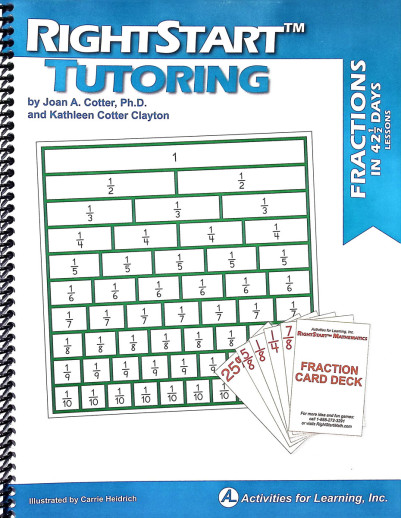We use cookies to make your experience better. To comply with the new e-Privacy directive, we need to ask for your consent to set the cookies. Learn more.
RightStart Tutoring Fractions Lessons Book
The lesson book is divided into 42 ½ daily lessons. Each lesson begins by stating the day's topic or goal of the lesson, a list of what you will need, and instructions for teaching the lesson. There is an appendix at the back that contains 7 reproducible pages that need to be copied for some of the games. Available in kit form, or separately for families using the Right Start program and who own the card decks and fraction charts.
This lesson manual teaches addition, subtraction, multiplication, and division of fractions as well as a solid introduction to percents. All this in just 42½ days!
Based on research comparing the differences between Japanese first grades and first grade classrooms in the U.S., this curriculum incorporates certain aspects from Asian math programs such as non-counting strategies and, for us, an alternative number naming system. In this program, the student is taught to see quantities in groups of fives and tens. When asked to add 9 + 7, instead of counting 7 up from 9, you would take 1 from 7 to make 10 and 6. This program also uses a unique number naming system. Asian words for numbers greater than 10 implicitly give you a feel for the base ten system. Literally translated, eleven is "ten-one," twelve is "ten-two," and so on. RightStart students learn to count the "math-way" before they are taught the less intuitive words for 11 to 19.
I cant summarize this program better than the creator, so let me quote from the manual:
"There are eleven major characteristics.
1. Refer to quantities of up to 3 as a group; do not count individually.
2. Use fingers to show quantities up to 10; teach 6 to 10 as 5 plus a quantity.
3. Avoid counting procedures for finding sums and remainders.
4. Once quantities 1 to 10 are known, proceed to 10 as a unit. Use the "math way" of counting; say for example, 1-ten 1 for eleven, 1-ten 2 for twelve, 2-ten for twenty, and 2-ten 5 for twenty-five.
5. Use expanded notation (overlapping) place-value cards for recording 10s and 1s
6. Proceed rapidly to hundreds and thousands; use place-value cards. Provide opportunities for trading between ones and tens, tens and hundreds, and hundreds and thousands with manipulatives.
7. Only after the above work, give the traditional English names for quantities 20 to 99 and then 11 to 19.
8. Teach tens-based strategies for addition and subtraction facts that have a sum > 10. Teach informal solutions and mental computation before written algorithmic work.
10. Teach four-digit addition and subtraction on the abacus; let the children discover the paper and pencil algorithms.
11. Short division precedes long division, which is taught in fourth grade."
In Level G, students continue to practice arithmetic, fractions and decimals, while they begin to also explore triangles, area, volume, ratios, Pythagorean Theorem, tiling, and other new concepts.
All levels require a lesson manual and worksheets, which are included in the starter kits. (The worksheets are also available separately for multiple students.) Lesson manuals contain detailed lesson plans with helpful diagrams and teaching notes. Both lesson manuals and worksheets are spiral-bound. Add on kits allow you to move forward, buying only what you need in addition to what you already have for the next levels. Deluxe Starter kits (and deluxe add-on kits) are now available, which include everything in the original kits, plus additional recommended books and manipulatives. Please note that if you start with a deluxe kit, you will need a different upgrade kit to transition to the next level. See individual descriptions for more details on kit-specific contents.~ Anh
Subtitled "Learn fractions in 42 ½ Days," this kit is great for those just beginning fractions or those struggling with them. 56 games and 17 worksheets are used to help students master addition, subtraction, multiplication, and division of fractions, and introduce percents. This isn't a conventional approach to learning fractions, but it works well with more active learners.
The kit includes the spiral-bound lesson book, spiral-bound worksheets, two plastic Fraction Charts, Basic Number Card Deck, Multiplication Card Deck and Fraction Card Deck. The Lesson book is divided into 42 ½ daily lessons. Each lesson begins with objectives, a list of what you will need, and instructions for teaching. An appendix includes seven reproducible pages that need to be copied for some of the games. The worksheets book is non-reproducible and contains 17 worksheets that are used with specific lessons. Three decks of cards are included. The Basic Number Deck includes 132 cards numbered from 0 to 10 (12 of each number). The Fraction Deck holds 75 cards with 20 different fractions and 20 matching percent cards. The Multiplication Deck includes 100 cards from 1x1 to 10x10 (there are duplicates of some cards). The two Fraction Charts are made of durable, heavy plastic – one is whole showing the markings of all the different fraction bars, and the other is separated into the different parts. Directions for using these are included in the lessons.
If you are already using RightStart™ Mathematics, you will notice that there is some overlap; some of the lessons are pulled from levels D and E and some games from the Math Card Games Book. This is a perfect supplement for the student who might be a little more visual or hands-on and needs more fractions practice.
| Product Format: | Paperback |
|---|---|
| Brand: | Activities for Learning |
| Grades: | K-7 |
| ISBN: | 9781931980548 |
| Length in Inches: | 11.125 |
| Width in Inches: | 9 |
| Height in Inches: | 0.25 |
| Weight in Pounds: | 0.65 |

